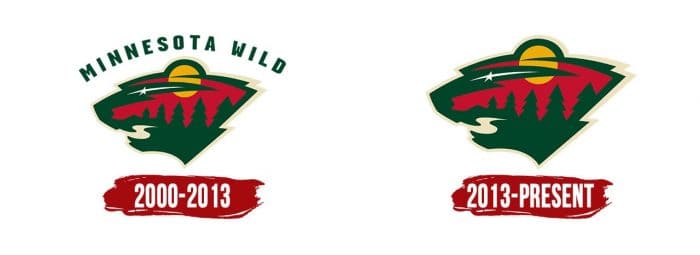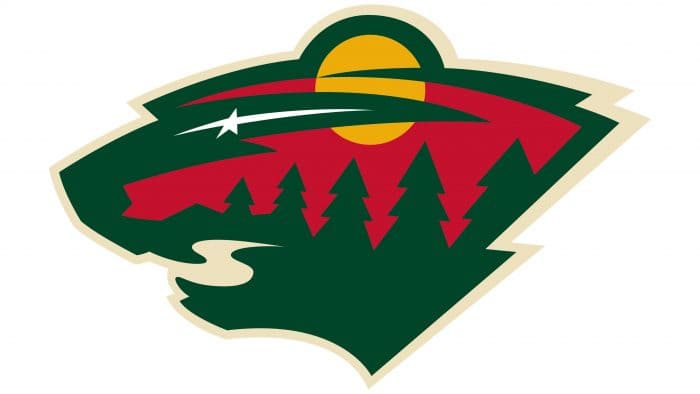Minnesota Wild
Minnesota Wild logo preview
Learn more about Minnesota Wild, find out the Minnesota Wild brand colors, and download Minnesota Wild vector logo in the SVG file format. Find related logos. Looking for a raster logo? Here you can download PNG Minnesota Wild logo on a transparent background as well.
Brand information
| Website | Minnesota Wild |
| Country | United States |
| Industry | Sports |
| Rating | 89/100 (50 votes) |
| Updated | Jun 11, 2024 |
The Minnesota Wild logo features yellow green red colors
This is a color scheme of Minnesota Wild. You can copy each of the logo colors by clicking on a button with the color HEX code above.
NHL logos
The Minnesota Wild are a professional ice hockey team based in Saint Paul, Minnesota. They are members of the Central Division of the Western Conference of the National Hockey League (NHL). The Wild were the only Minneapolis–Saint Paul area major professional sports league franchise to play in Saint Paul until Minnesota United FC moved to their new home, Allianz Field, in 2019. The other three teams play in Minneapolis.

Minnesota Wild is an expert ice hockey group that plays in the National Hockey League. She is an individual from the Western Conference and contends with the Central Division. The club was framed on June 25, 1997, and is situated in St. Paul, Minnesota, where it plays at the home arena of the Xcel Energy Center. It is perceived as the principal NHL establishment in the area.
Meaning and History

Even though this hockey group showed up toward the finish of the 90s of the last century, it began to contend a lot later. The competitors played their first season in 2000, which is why it is viewed as the date of the group’s actual appearance. It is presently claimed by Craig Leipold and overseen by Bill Guerin. Dignitary Evason briefly prepares hockey players.
Since its origin, the establishment has not moved anyplace and seldom modified the idea, reflected in the brand imagery. The token remained practically unaltered, with uncommon exemptions when present-day variation to different media was required. Excellent permeability, imaginativeness, and simplicity of insight are their principle necessities, reflected in the logo’s present variant. By and large, he just once updated the logo for the whole time of the club’s presence.
2000 – 2013

Between these seasons, the establishment utilized an introduction form. Since it is named “Wild” and Minnesota is wealthy in forests, the image depended on a scene with conifers. Tall tidy trees with three-sided outlines underline the sharpness of the competitors’ person and their desire for triumph.
The logo highlights interlaced trees: green at the base, red at the top. They are consolidated to comprise two foundation spaces: a red mountain range and wild green timberland. Albeit the components don’t converge in shading, they structure a solitary picture, where everything is inseparably connected.
A logo is a scene drawing that assumes the part of visual duplicity, a dream. It seems, by all accounts, to be around the yellow moon, yet it is the ear of a monster. A splendid falling star is apparent above, yet incidentally, this is a creature’s eye. You check out the stream fleeing into the distance, yet you understand that this is the vast mouth of a hunter.
The cover is available in all things – even in the blueprint since the symbol shows the top of a gigantic hold for a medium-wide beige edging. Directly above it is the word-blend “Minnesota Wild,” made as a curve.
2013 – present

In 2013, the exclusive logo update was attempted. Since the hockey club suits everything: secret, creativity, imaginativeness, and two-sided connotation. The last means the presence of variety in the brand imagery.
The primary thing that gets your attention is the scene mirroring the Minnesota woods fields. In any case, the second is significantly more significant – a shape component as a wild monster found in the neighborhood ghettos. This stayed unaltered after the update of the logo. Just the engraving at the top vanished because the group chose to zero in on the drawing by amplifying the primary image – the top of a furious bear.
Logos related to Minnesota Wild from the Sports Industry
Frequently Asked Questions (FAQ) about the Minnesota Wild Logo
The Minnesota Wild logo is one of the NHL logos and is an example of the sports industry logo from United States. According to our data, the Minnesota Wild logotype was designed for the sports industry. You can learn more about the Minnesota Wild brand on the nhl.com/wild website.
Most logos are distributed vector-based. There are several vector-based file formats, such as EPS, PDF, and SVG. Simple images such as logos will generally have a smaller file size than their rasterized JPG, PNG, or GIF equivalent. You can read more about Raster vs Vector on the vector-conversions.com.
SVG or Scalable Vector Graphics is an XML-style markup-driven vector graphic rendering engine for the browser. Generally speaking, SVG offers a way to do full resolution graphical elements, no matter what size screen, what zoom level, or what resolution your user's device has.
There are several reasons why SVG is smart to store logo assets on your website or use it for print and paper collateral. Benefits including small file size, vector accuracy, W3C standards, and unlimited image scaling. Another benefit is compatibility — even if the facilities offered by SVG rendering engines may differ, the format is backward and forward compatible. SVG engines will render what they can and ignore the rest.
Having the Minnesota Wild logo as an SVG document, you can drop it anywhere, scaling on the fly to whatever size it needs to be without incurring pixelation and loss of detail or taking up too much bandwidth.
Since the Minnesota Wild presented as a vector file and SVG isn’t a bitmap image, it is easily modified using JavaScript, CSS, and graphic editors. That makes it simple to have a base SVG file and repurpose it in multiple locations on the site with a different treatment. SVG XML code can be created, verified, manipulated, and compressed using various tools from code editors like Microsoft VS Code or Sublime Text to graphic editors such as Figma, Affinity Designer, ADOBE Illustrator, and Sketch.
You can download the Minnesota Wild logotype in vector-based SVG (Scalable Vector Graphics) file format on this web page.
According to wikipedia.org: "A logo (an abbreviation of logotype, from Greek: λόγος, romanized: logos, lit. 'word' and Greek: τύπος, romanized: typos, lit. 'imprint') is a graphic mark, emblem, or symbol used to aid and promote public identification and recognition. It may be of an abstract or figurative design or include the text of the name it represents as in a wordmark."
Logos fall into three classifications (which can be combined). Ideographs are abstract forms; pictographs are iconic, representational designs; Logotypes (or Wordmarks) depict the name or company's initials. Because logos are meant to represent companies brands or corporate identities and foster their immediate customer recognition, it is counterproductive to redesign logos frequently.
A logo is the central element of a complex identification system that must be functionally extended to an organization's communications. Therefore, the design of logos and their incorporation into a visual identity system is one of the most challenging and essential graphic design areas.
As a general rule, third parties may not use the Minnesota Wild logo without permission given by the logo and (or) trademark owner NHL. For any questions about the legal use of the logo, please contact the NHL directly. You can find contact information on the website nhl.com/wild.
We strive to find official logotypes and brand colors, including the Minnesota Wild logo, from open sources, such as wikipedia.org, seeklogo.com, brandsoftheworld.com, famouslogos.net, and other websites; however, we cannot guarantee the Minnesota Wild logo on this web page is accurate, official or up-to-date. To get the official Minnesota Wild logo, please get in touch with the NHL directly or go to nhl.com/wild.
By downloading the Minnesota Wild logo from the Logotyp.us website, you agree that the logo provided "as-is." All the materials appearing on the Logotyp.us website (including company names, logotypes, brand names, brand colors, and website URLs) could include technical, typographical, or photographic errors or typos.
We do not claim any rights to the Minnesota Wild logo and provide the logo for informational and non-commercial purposes only. You may not use or register, or otherwise claim ownership in any Minnesota Wild trademark, including as or as part of any trademark, service mark, company name, trade name, username, or domain registration. You do not suppose to share a link to this web page as the source of the "official Minnesota Wild logo" Thank you.
The color red is a warm, vibrant color that is often associated with strong emotions such as passion, love, and anger. It is also often associated with power, strength, and determination. In design, red can be used to create a bold, attention-grabbing visual impact. It is also often used to represent danger or warning, as it is the color of stop signs and warning lights. In fashion, red is often used to add a pop of color to an outfit and can be used to make a statement or stand out in a crowd. The color red is also associated with love and romance, and is often used in Valentine's Day and Christmas decorations. The color yellow is a bright, cheerful color that is often associated with happiness, optimism, and sunshine. It is a warm color that is often used to create a happy and welcoming atmosphere. In design, yellow is often used to add a touch of cheerfulness and brightness to a space. In fashion, yellow is often used to add a pop of color to an outfit and can be used to create a playful, energetic look. The color yellow is also often associated with caution and warning, as it is the color of many traffic signs and warning lights. Green is a color that is often associated with the natural world. It is a cool, refreshing color that is often described as being calming, soothing, and revitalizing. Green is the color of grass and trees, and is often associated with growth, renewal, and nature. It is also often associated with health and wellness. In terms of its psychological effects, green is often seen as a balancing color that can help to create a sense of calm and harmony. It is often used in design to create a sense of tranquility and relaxation. There are many different shades of green, ranging from a pale, almost minty green to a deep, rich forest green. Different shades of green can have slightly different associations and psychological effects, with lighter shades often being seen as fresher and more energetic, while darker shades are often seen as more rich and luxurious.
It's important to note that these associations are not universal, and different people may have different emotional responses to colors.

